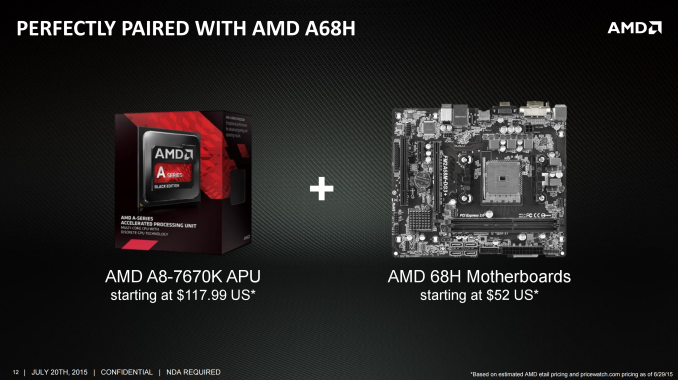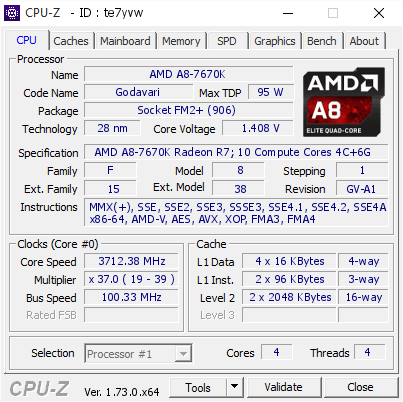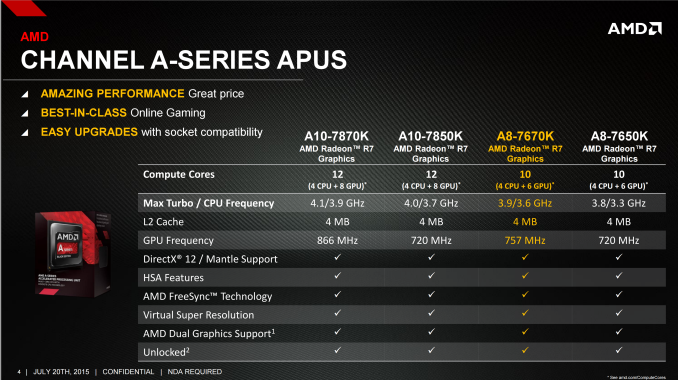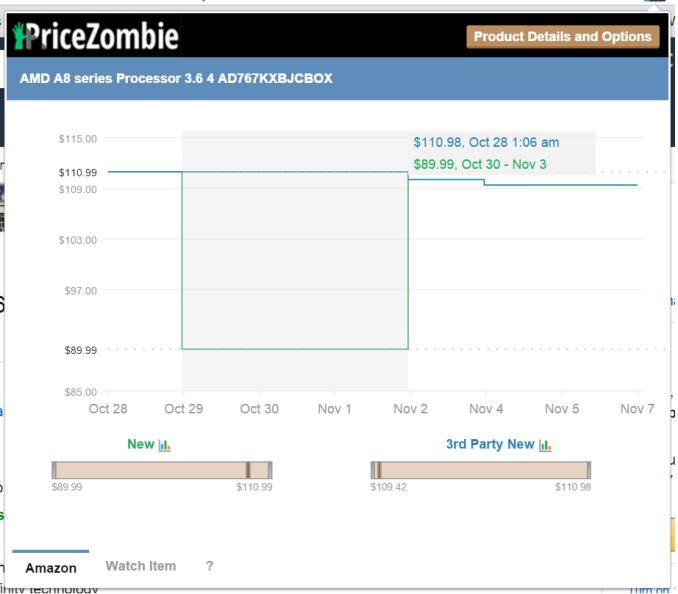The AMD A8-7670K APU Review: Aiming for Rocket League
by Ian Cutress on November 18, 2015 8:00 AM EST
Over the past couple of years, AMD has slowly released their mainstream brand of Kaveri processors. In turn, we have reviewed them, and they consistently aim to provide a midrange integrated gaming option, especially for those on a budget. The recent release of the A8-7670K was perhaps not that exciting, as AMD is filling up their product stack with new parts, taking advantage of an improved manufacturing process and aggressive binning. To that end, we're taking a different tack with this review. Alongside the regular tests, we also corralled Rocket League (an amazingly simple yet popular take on car football/soccer that sits on the precipice of e-sports glory) into a benchmark aimed at those sub-$600 gaming systems.
The AMD A8-7670K
Earlier this year, AMD announced their new line of Kaveri Refresh processors, starting with the A10-7870K (which we reviewed here). As the name suggests, these are Kaveri processors at their core, still based on the combination of Steamroller processor cores and 2nd generation Graphics Core Next (GCN) microarchitecture for graphics. These new refresh models are designed to take advantage of minor improvements in manufacturing, resulting in the ability to get higher clock speed for the same power consumption, even 18 months after the first Kaveri processors hit the scene. As a result, these Refresh processors — or, to use AMD's internal code name, "Godavari" — fill in the blank spots in the product stack and supersede the older parts, with the aim of squeezing in more frequency and performance for the same power consumption. It sounds deceptively simple — improve your process, refresh the part at the same price, and reap the benefits.
If we look at AMD's current lineup, we see that this new A8-7670K surpasses the older A10-7700K on the specification sheet, and comes in cheaper when brand-new.
| AMD Kaveri Lineup | ||||||||
| A10- 7870K |
A10- 7850K |
A10- 7800 |
A10- 7700K |
A8- 7670K |
A8- 7650K |
A8- 7600 |
X4 860K |
|
| Price | $137 | $134 | $131 | $120 | $118 | $104 | $89 | $85 |
| Modules | 2 | 2 | 2 | 2 | 2 | 2 | 2 | 2 |
| Threads | 4 | 4 | 4 | 4 | 4 | 4 | 4 | 4 |
| Core Freq. (GHz) | 3.9-4.1 | 3.7-4.0 | 3.5-3.9 | 3.4-3.8 | 3.6-3.9 | 3.3-3.8 | 3.1-3.8 | 3.7-4.0 |
| Compute Units | 4+8 | 4+8 | 4+8 | 4+6 | 4+6 | 4+6 | 4+6 | 4+0 |
| Streaming Processors |
512 | 512 | 512 | 384 | 384 | 384 | 384 | N/A |
| IGP Freq. (MHz) | 866 | 720 | 720 | 720 | 754 | 720 | 720 | N/A |
| TDP | 95W | 95W | 65W | 95W | 95W | 95W | 65W | 95W |
| DRAM Frequency |
2133 | 2133 | 2133 | 2133 | 2133 | 2133 | 2133 | 1866 |
| L2 Cache | 2x2MB | 2x2MB | 2x2MB | 2x2MB | 2x2MB | 2x2MB | 2x2MB | 2x2MB |
As it stands, the A8-7670K is a dual-module 3.6 GHz base frequency processor with a boost frequency up to 3.9 GHz. It comes with six graphics compute units, which translates to 384 streaming processors, similar to other A8 parts, but at a slightly higher IGP frequency of 754 MHz. The combined increase in processor and integrated graphics frequencies come at no extra cost in thermal design, with the A8-7670K at the same 95W TDP.
One of AMD's marketing strategies with these ~$100 processors is the price/performance angle. Aside from the integrated graphics, each of the AMD processors can pair with an R7 240 or R7 250 graphics card (DDR3 or GDDR5; AMD suggests an R7 250 GDDR5, as you might expect) in a hybrid dual graphics scenario, boosting performance. Thus, for the same price as an APU and an R7 250 graphics card, on average, AMD aims to offer a better gaming experience — especially for games that run at around 60 frames per second on medium settings — than a similarly priced Intel + NVIDIA platform. We've seen this marketing spiel corroborated in previous reviews, and would expect not to see anything different here. At launch, AMD put a $118 price on the A8-7670K, which, in recent sales, has been pushed down to under $100 at times.
The A8-7670K is an FM2+ socket processor, and thus requires either an A88X, A85X, A78 or A68 motherboard to go with it in order to take full advantage. As part of the launch, and given that this processor is a slightly boosted A8-7650K, AMD sees value in pairing it with something like a $50 A68H motherboard, making an APU+MB combination around $150 when on sale. However, as one might imagine, due to the age of the FM2/FM2+ socket, there are relatively few "new" motherboards on the market. The last one we reviewed was MSI's A88X-G45 Gaming, which brought over some of the components seen on its new Intel gaming motherboards, but other manufacturers have also put out M.2 capable AMD chipset-based motherboards as well.













154 Comments
View All Comments
AS118 - Wednesday, November 18, 2015 - link
Well to be fair, the FX chips are strong enough and cheap (especially the $100 FX-6300) and you can pair them with a discrete GPU with ease. If you're trying to get a 1080p gaming rig for absolute cheapest price, a double AMD FX / GPU build works pretty well.That said, next year with Zen on 14nm will probably give people a good reason to get AMD. I just support AMD whenever I can because I dislike monopolies, and don't want Nvidia and Intel to become ones.
Sure they give good price for performance NOW, but that's because they have AMD to compete with them. If they didn't, I doubt the price would be "only a little higher" than AMD.
Oxford Guy - Wednesday, November 18, 2015 - link
8320E at $110 at Microcenter with UD3P 2.0 board is the best deal.JoeMonco - Wednesday, November 18, 2015 - link
"That said, next year with Zen on 14nm will probably give people a good reason to get AMD."Yeah, yeah. We hear this ever time a new AMD microarchitecture comes out and yet not a single one has lived up to the hype in more than a decade.
medi03 - Thursday, November 19, 2015 - link
Do you get paid to spread FUD about AMD or is it for free?JoeMonco - Thursday, November 19, 2015 - link
How can facts be "FUD"? If I'm wrong, please do tell which AMD CPU has been able to beat Intel in anything performance or TDP-wise since the Core2 from 2006. I won't hold my breath, though, since you'll just sling ad homs with no real facts.Deshi - Friday, November 20, 2015 - link
Yes, and that would be because only one new architecture (buldozer and its many variants) has been released in that past Decade, and we all know how that played out. Before that Athlon actually beat Intel for a good amount of time, and the same guy that worked on that is working on Zen. I'm somewhat hopeful that it won't be a bad design decision this time. I'm just hopeing its not too late. back in Athlon days, Intel was too pridefull and choose to ignore AMD initially, which is why AMD was able to take so much market share from them. I don't expect Intel to make the same mistake again this time.alistair.brogan - Wednesday, November 18, 2015 - link
This review doesn't compare with the new Pentium G4500. Skylake Pentium CPU cores with i5 Skylake integrated graphics. Faster and 1/3 the electricity/heat compared with the AMD APU. Only advantage amd has left is how some newer games don't run right without quad core, as they are bad ports from consoles....alistair.brogan - Wednesday, November 18, 2015 - link
50 dollars cheaper too, in Canadaalistair.brogan - Wednesday, November 18, 2015 - link
40-50 fps borderlands 2 on minimum settings (30-40 ultra settings) with HD 530 and the G4500Ian Cutress - Thursday, November 19, 2015 - link
As posted above, we don't have any of the other Skylake processors in yet. Benchmarking is always an iterative task - with limited space and resources you can't all benchmark them on the same day.But sure, if I could get all the processors in on day one, I would totally try test them all for comparion points.
Come back when/if we test the G4500 and see the numbers then.
And no, it's not a simple case of going out and buying this one SKU just for the niche comparison that you're interested in - there have been requests in the comment sections of reviews for other SKUs as well, and I've had a couple of emails for more SKUs on top of that.
Some SKUs are region limited (or slow roll out), or others are OEM only, so it can be hard to source outside the usual channels. So let me try and talk to Intel so we can get them all in, and then go from there. It's never an issue of lack of interest or subversion, just procurement (and ensuring we can communicate with the manufacturer at the point of testing).
Of course, the more readers that register their interest, the more I can pass it on up the chain to get them in.